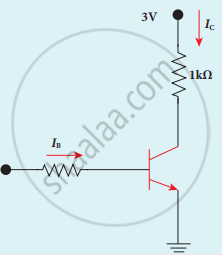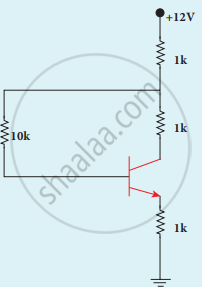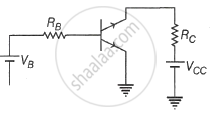Advertisements
Advertisements
Question
Explain the working of the n-p-n transistor in a common base configuration.
Solution

The common base configuration for n-p-n transistor
In a Common Emitter configuration, the emitter of the transistor is common to both the input and the output.
Working:

Biasing of n-p-n transistor
- The majority of charge carriers in the emitter of the n-p-n transistor are electrons.
- In the above figure, the emitter-base junction is forward-biased while the collector-base junction is reverse-biased.
- At the instant when the EB junction is forward biased, electrons in the emitter region have not entered the base region as shown in the below figure.

Injection of majority carriers into base - These electrons can either flow through the base circuit and constitute the base current (IB), or they can also flow through the collector circuit and contribute towards the collector current (IC).
- The base is thin and lightly doped, the base current is only 5% of IE.
- Electrons injected from the emitter into the base diffuse into the collector-base depletion region due to the thin base region. When the electrons enter the collector-base depletion regions, they are pushed into the collector region by the electric field at the collector-base depletion region. collector current (IC) flows through the external circuit as shown in the below figure. The collector's current IC is about 95% of IE.

Electron flow through a transistor - From the above figure, we can conclude that IE = IB + IC. Since the base current IB is very small we can write IC ≈ IE.
APPEARS IN
RELATED QUESTIONS
Why is the base of a transistor made thin and is lightly doped?
Explain the working of the PNP transistor?
Draw the circuit symbol for NPN and PNP transistors. What is the difference in the Emitter, Base, and Collector regions of a transistor?
With the help of a neat diagram, explain the working of the npn transistor?
The principle based on which a solar cell operates is ____________.
The output of the following circuit is 1 when the input ABC is

Explain the current flow in an NPN transistor.
Explain the need for a feedback circuit in a transistor oscillator.
What is rectification?
Assuming VCEsat = 0.2 V and β = 50, find the minimum base current (IB) required to drive the transistor given in the figure to saturation.

A transistor of α = 0.99 and VBE = 0.7 V is connected in the common-emitter configuration as shown in the figure. If the transistor is in the saturation region, find the value of collector current.

If l1, l2, l3 are the lengths of the emitter, base and collector of a transistor, then ____________.
If `alpha`-current gain of a transistor is 0.98. What is the value of `beta`- current gain of the transistor?
In an npn transistor, the collector current is 24 mA. If 80% of electrons reach collector, its base current in mA is ______.
In case of npn transistors, the collector current is always less than the emitter current because ______.
A transistor is connected in C - E mode. If collector current is 72 × 10-5 A and α = 0.96, then base current will be ______.
A transistor having α = 0.8 is connected in a common emitter configuration. When the base current changes by 6 mA, the change in collector current is ______
A common emitter amplifier has a voltage gain of 50, an input impedance of 100Ω and an output impedance of 2000Ω. The power gain of the amplifier is ______.
A transistor is used as a common emitter amplifier with a load resistance 2 KΩ. The input resistance is 150 Ω. Base current is changed by 20 µA which results in a change in collector current by 1.5 mA. The voltage gain of the amplifier is ______.
For a transistor, αdc and βdc are the current ratios, then the value of `(beta_"dc"-delta_"dc")/(alpha_"dc".beta_"dc")`
In a p-n-p transistor circuit, the collector current is 10 mA. If 90% of the holes emitted from the emitter reach the collector, ______.
A common emitter amplifier circuit built using an n-p-n transistor is shown in the figure. Its DC current gain is 300, RC = 4 kΩ and VCC = 20 V. What is the minimum base current for VCE to reach saturation?

The base current in common emitter mode of the transistor changes by 10 µA. If the current gain of the transistor is 50, then change in collector current is ______.
The collector current in a common-emitter transistor amplifier is 4 mA. When the base current is increased by 20 µA, the collector current increases to 6 mA. The current gain is ______.
How is a transistor biased for operating it as amplifier?
In a CE amplifier, the current gain is 80 and the emitter current is 9 mA. The base current is ______.
Define α.
